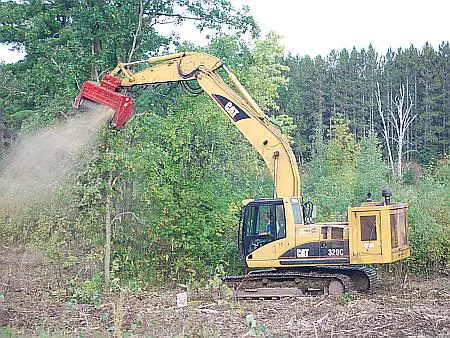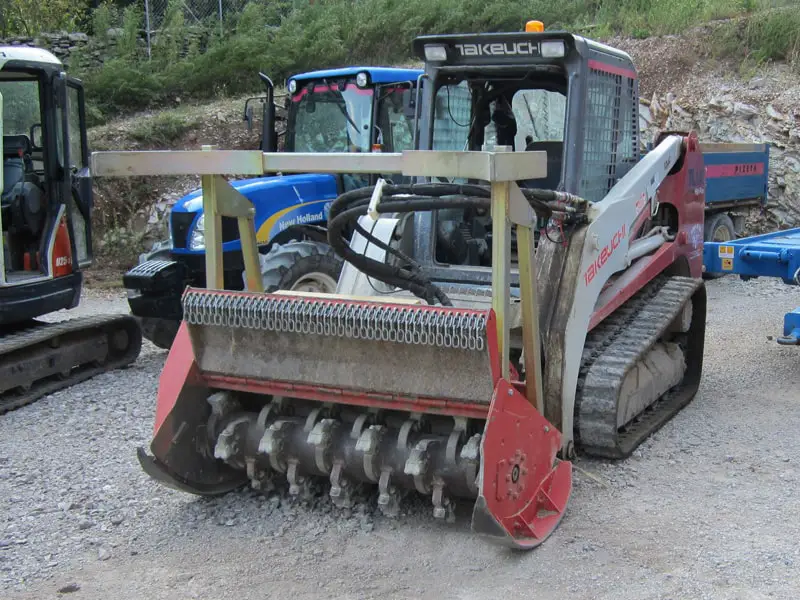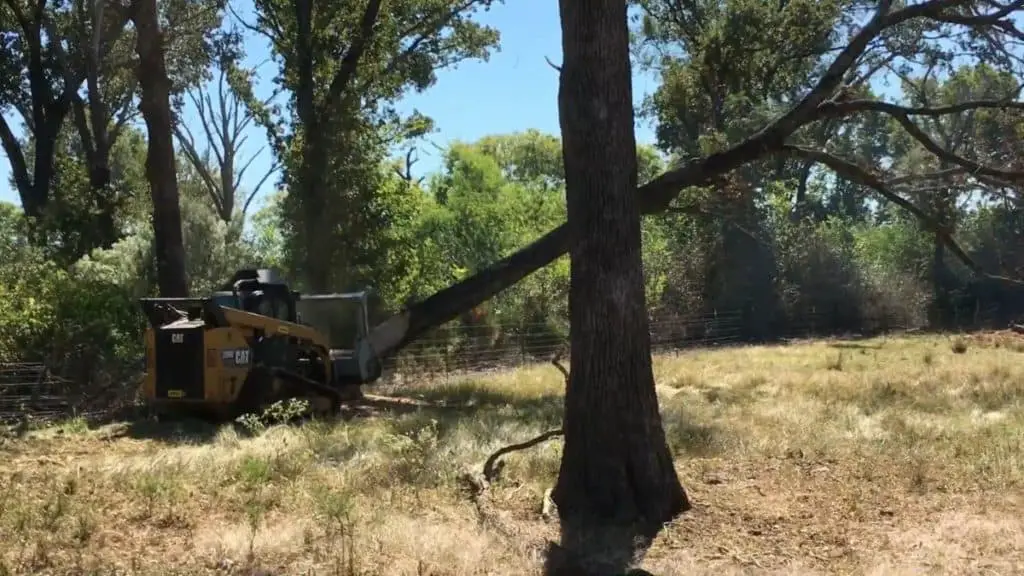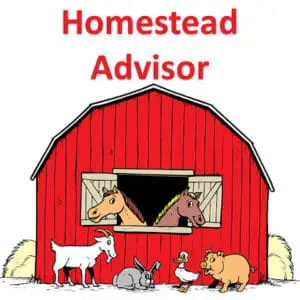Clearing land can be backbreaking work, but there are machines that can save you an enormous amount of time. A Forestry Mulcher is one of those machines. I’ve had a Forestry Mulcher on my property on three different occasions, and I can absolutely recommend that type of service to clear your land.
A competent operator on a forestry mulcher can absolutely transform an overgrown piece of property into a beautiful landscape. My property was overgrown with acres of brush and scrub trees that had grown-up and regenerated over the last forty or fifty years.
The brush had literally taken over much of my property. Some of the undergrowth reached 20 or 30 ft tall. These weren’t trees. They were just undergrowth, bushes, small saplings, and other woody plants. I also had a lot of willows along my creek banks.
Many of the trees were 6 to 8 inches in diameter, some were much larger. I’ll tell you about the very large trees the operator took down later. So, let’s take a look at the machine, and what it is capable of.

The Forestry Mulcher
If you’re not familiar with what a Forestry Mulcher is, then let me explain. It’s a land clearing beast! It is a piece of equipment that is designed to reduce, grind, and clear vegetation. And, unlike most things, it works exactly as designed. Sometimes referred to as a masticator, or brush-cutter, it uses a huge rotary drum laden with steel chipper tools (“teeth”) to shred plant materials.
These teeth are typically secured to a steel drum that rotates on a horizontal axis. As the “drum” rotates, the teeth chew through any and all vegetation. You’ve probably seen Stump Grinders. They have a small cutting surface and will grind stumps till they are at or below ground level. Well, this is a stump grinder on steroids!
The mulching head on a Forestry Mulcher can do a much larger area, and it does it fast. Most of these mulching heads are probably six feet wide or more, which means as the operator moves through the property, they are covering a wide path as they go. And heaven help whatever is in its way because it’s going to get converted to wood mulch.
They are usually mounted to a skid steer, but there are also applications that allow a mulching head to be mounted on the back of a three-point hitch on a tractor and be powered by the tractor’s PTO (power take-off). They can even be mounted on a track-hoe arm and perform high-level mulching.
The mulching head is driven by hydraulics when mounted to the front of a skid steer. The amount of work that a Mulcher can do is dictated by the flow of hydraulic fluid that the skid steer produces. That’s called GPM or gallons per minute. It takes a lot of hydraulic pressure to run these mulchers, especially when they are grinding into something hard like a tree.
Typically, the forestry mulcher will (if grinding on a tree or something else big) have to stop from time to time to let the mulching head regain its speed. In other words, the head will slow down as they are grinding on something. then it needs a second or two to catch back up to full RPM. Then it will resume grinding on whatever it was working on.
Some of the larger skid steers, with a lot of hydraulic pumping capacity, can work without doing a lot of stopping for the head to catch up. They pump enough hydraulic fluid that the mulching head can do a lot of work without bogging it down.
How It Works
As I said before, there are teeth bolted to the rotating drum. And again, the drum is rotating on a horizontal access. I’m not sure how many RPMs it’s going, but it’s fast.
As the operator moves into the brush or trees, those teeth will viciously chew up everything that they are forced into by the power of the skid steer. He will move forward, and his forward speed will depend on the size of the vegetation that he is grinding up. If the vegetation is saplings or small trees, he will move slower through the vegetation than he would if it was just small brush and weeds.

Safety dictates that you stay well in front of or behind skid steer as it approaches vegetation. It’s advised that you are to the side of the machine. The mulching head can throw debris both forward and backward underneath the skid steer, so it’s not even safe to stand behind it. It’s a pretty cool thing to watch, but be careful where you stand.
I did a lot of videos for my YouTube Channel when he was on my property, but I was also trying to be careful and not get hit by flying debris. There were many times when I saw a limb or a chunk of tree thrown 150 ft or more by the mulcher.
The Cost
Most forestry mulchers will probably work on an hourly basis. You might find someone to come in and give you a bid for your job on a flat rate. That might be nice considering you will know exactly what you’re going to spend before he starts. But, he could also be overpricing the job to account for any possible problems.
I am fortunate in that a neighbor nearby has a mulching service. He didn’t charge me a setup fee. Typically, there is a setup fee for him to bring the machine to your property, then there is a per hour charge for the actual work.
In my case, the owner charged around $200 per hour. He typically charges a $200 setup fee plus the $200 per hour, but as I said before, I did not have to pay the setup fee. Also, my neighbor’s operation utilizes two mulching heads. This could be important to you. If there is only one mulching head, and one operator, then there’s going to be downtime when he needs to sharpen the teeth on the mulching head.
And if he’s on your property very long, he’s probably going to have to sharpen those teeth. In my case, there were 2 mulching heads and 2 operators. When the teeth needed sharpening, one of the operators sharpened the teeth on one mulching head, while the other kept working with the other head on the skid steer.

You will probably only be charged for the hours on the machine. My operator documented the hours on the machine when he started and when he finished. That means if the skid steer engine is running, you are paying for that time. As long as the machine is actively working to clear property, that’s not a problem. However, if the machine was sitting still, and the engine is idling, he’s not working, and yet you are being charged for that time.
So it wouldn’t hurt to be on-site while the land clearing is being done. An unscrupulous company could let the skid steer sit with the engine at an idle for an hour or so while they take a lunch break, and you would get charged for that hour.
I didn’t have that problem, but it is something to remember, and something to watch out for. I would check beforehand as to how the hours are calculated. Make sure it’s hours “on the machine” and not hours spent on your property. You only want to pay for what you’re getting.
Small and Large Acreages
So, is this only feasible for large acreages, or just for small acreages? Obviously, with large areas come larger price tags. There are those that say a large forestry mulcher should be able to do 15 acres in a day. I did not find that to be true, but my operator had a smaller machine, and as I mentioned before they were taking down a lot of large trees. Taking down trees is more time consuming than ripping through the brush.
But, I had a strategy to keep the cost low when they were clearing my property. I happen to own a fairly large tractor and I told the owner of the company I did not want the large trees to be mulched up. That would have taken a long, long time. That was machine time I would have been paying for, and I just couldn’t afford that.
What I told him to do was to mulch all the brush, and mulch the smaller trees. When he came to a large tree he was to take it down (if he could do so safely) and then I would come back with my tractor, cut it up into manageable sections, and take it to a burn pile with my forks or my grapple.
So that’s what I did, and it worked out great. I had a couple of huge burn piles to dispose of, but it saved me countless hours on that machine. At $200 an hour, that meant I saved a lot of money. It meant more labor for me having to haul the trees off and burn them at a later date, but I was quite willing to trade my time (which was free) for his time (which was not).
Also, the machine that came to my house was a small forestry mulcher. Larger machines could possibly do 15 acres or even more if the material to be taken down is small and doesn’t include large trees. But bear in mind, larger machines that can do the work quicker will probably cost you more per hour.
What About Large Trees?
I also had a lot of huge dead trees. In Texas, there is a disease (oak canker) that is affecting oak trees, and it is devastating to them. My property was covered with huge hundred-year-old oak trees, but many of those trees have succumbed to this canker, and sadly have died. The forestry mulcher took down every one of those dead trees.
Now, maybe not every operator would want to tackle that, but this operator was completely unafraid to do it. Many of the trees were at least two feet in diameter, some were well over three feet in diameter, and yet he took them down with a small forestry mulcher. In fact, the owner of the company told me it was one of the smaller skid steers that would handle that size mulching head.
So, from my experience, it’s more of a question of the operator’s competency than it is the size of the forestry mulcher. In this case, I’m not sure size matters. So let’s take a look at this machine, and what it can actually do against a large tree.

As I mentioned before, the operator on my property also took down a number of large trees. What he would do would be to move up slowly to the tree, dig into the side of it and cut a chunk out of it almost as if you were notching a tree with a chainsaw. after he chewed up one side of the tree to his satisfaction, he would move to the other side and chew on it also.
There is a heavy bar located above the mulcher head that is a tree pusher of sorts. After the operator felt that he had notched the tree enough he would begin to push on it with the bar. Most times he would have to go back and notch it some more with the mulching head, but he never failed to take down a tree.
As I said before, some of them were huge 50 to 60 ft oak trees three feet in diameter, that had been dead a year or two. Dead oak is hard. But he was able to take each and every one of them down. Those mulching heads are amazing, and at the same time… terrifying… in a good way.
Residue Cleanup
So what is left when they are through? Well, if the operator is very conscientious they will leave nothing but wood chips on the ground. There should be no stumps sticking up from any of the small bushes or saplings.
Most operators will move forward into the vegetation, grinding and mulching it up, and then back up over the area they just covered, grinding up anything that might be left. That could be a small stump sticking up or some limbs or other debris that did not get mulched completely. If he does this, it is very likely that you will have no tree stumps or anything else sticking up that might give you any problems down the road.

I hope this has given you enough information for you to make an informed decision on whether a Forestry Mulcher is right for your property. But there may be some instances in which this may not be the right method of clearing land.
Since this method clears the vegetation but leaves the stump in the ground, this would not be a good method if the land was going to be used for farming. If the land is to be plowed and planted in a crop, the stumps would need to be pulled up out of the ground. If you are clearing for farming, forestry mulching is not right for you.
In my case, this worked out wonderfully. It’s hard to look at my land now and visualize what it was like before. It was so overgrown that I couldn’t even drive through it on my four-wheeler. I spent about $5,000 getting around eight acres cleared out, and it was the best money I have spent in a long, long time.
I know your time is valuable, so as always, I sincerely thank you for spending it here.
My YouTube Channel has around 800 videos documenting the Forestry Mulching process and many other Homesteading, Gardening, livestock, and Emergency Preparedness issues. You can find it HERE


